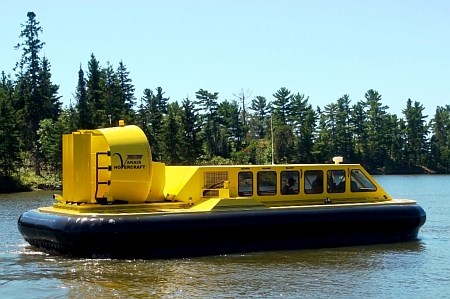Dave Van Dam isn’t one given to self-promotion.
The owner of Vanair Hovercraft doesn’t spend a lot of money on mass marketing and advertising his air-cushioned vehicles.
If people want one to buy or lease one of his craft, his Kenora company is only a few mouse clicks away on his website. His non-descript warehouse on Highway 17 gives no indication, aside from a small sign, of any major boatworks on the premises.
Van Dam likes it that way.
The quiet-spoken Kenora businessman is a no-nonsense and admittedly low-key fellow. He is guarded about how many craft his company has sold since starting Vanair in 1999.
It’s safe to say Vanair Hovercraft is a global exporter with 30 distributors internationally.
“Everybody’s trying to find out what we’re doing and where we sell them. I don’t talk about it.”
Building commercial and industrial hovercraft is very much a competitive and niche market. Few companies in the world do it and those that do are very protective of their market share.
During an interview in May, Van Dam fielded cold calls from Bangladesh, Argentina and the United States. On the latter inquiry, he politely informs the caller that the Jones Act – a protectionist American trade law enacted in the 1920s – prohibits him from selling his vessels in that country.
For the others, he e-mails them a detailed questionnaire to better gauge their passenger, payloads and speed requirements.
“They’re built to order. They’re not sitting in the lot waiting for someone to kick the tires.”
There’s no retail showroom or inventory of vessels, but generally the company can deliver one within six to eight months of order. An 18-seater runs about $600,000, with the 25-seater in the $750,000 range. In an average year, Vanair will produce between 12 and 14 craft. All the manufacturing, painting and parts-making work is contracted out to a Winnipeg fabrication firm, Enduron Custom Inc.
For larger-sized craft and a government contract of multiple vessels, he’ll go to a shipbuilder at a seaport.
“I don’t have millions of dollars tied up in equipment. I sub everything out,” said Van Dam.
The Kenora shop, which is the sales and research and development headquarters, simply doesn’t have the facilities and available manpower.
Van Dam, a former RCMP officer, is a pilot and aircraft engineer who has been orking with hovercraft for 35 years, mostly selling recreational versions on Lake of the Woods from a very successful Kenora marine dealership, Pat’s Outboard Marine.
When he sold the business in 1993, he scanned the market and saw nobody was building commercial hovercraft in North America.
He saw one sturdy version and worked with the original engineer to take the basic design and make it more stylish and well-appointed for use as a water taxi. He added a large cargo door, revamped the control console and used materials that deadened the engine sound inside the passenger cabin.
He has sold some in Africa and points to a framed article inside his sparsely furnished office from a Swedish newspaper where he made his most recent delivery, a V-18, his signature 18-passenger craft.
The company is capable of designing and building hovercraft ranging in size from 12-passenger, nine-metre models, all the way to 15-tonne payload hover freighters for logging, mining and oil exploration.
The durable aluminum-hulled vessels are built to coast guard standards and are all powered by Cummins Diesel engines. The craft are used as ferries, medevacs, tour boats, for search and rescue, law enforcement and by the military. They can run year-round through ice-clogged harbours and channels and can move people and freight at speeds of up to 60 kilometres an hour.
They are also popular for passenger transport in remote Aboriginal and island communities, impoverished Third World countries where roads are nonexistent, and congested cities where the only transit alternative is by water.
Van Dam has taken advantage of federal research grants to build prototypes. His latest is the nine-seat Vixen. Its unique feature is that the large rear propeller used on conventional hovercraft is replaced by fans for lift and propulsion, thereby making it 50 per cent quieter. It’s designed for noise-sensitive areas, and possibly has some military use.
However, Van Dam isn’t satisfied with its performance, so that model is about a year away from hitting the market.
The vehicles are also available for leasing and the company helps arrange financial assistance. Training is included in any sale or lease cost. Vanair provides three days of operator and maintenance to prepare for coast guard certification. Options can be added such as radar, air conditioning, life raft, engine heater and custom trailer.




